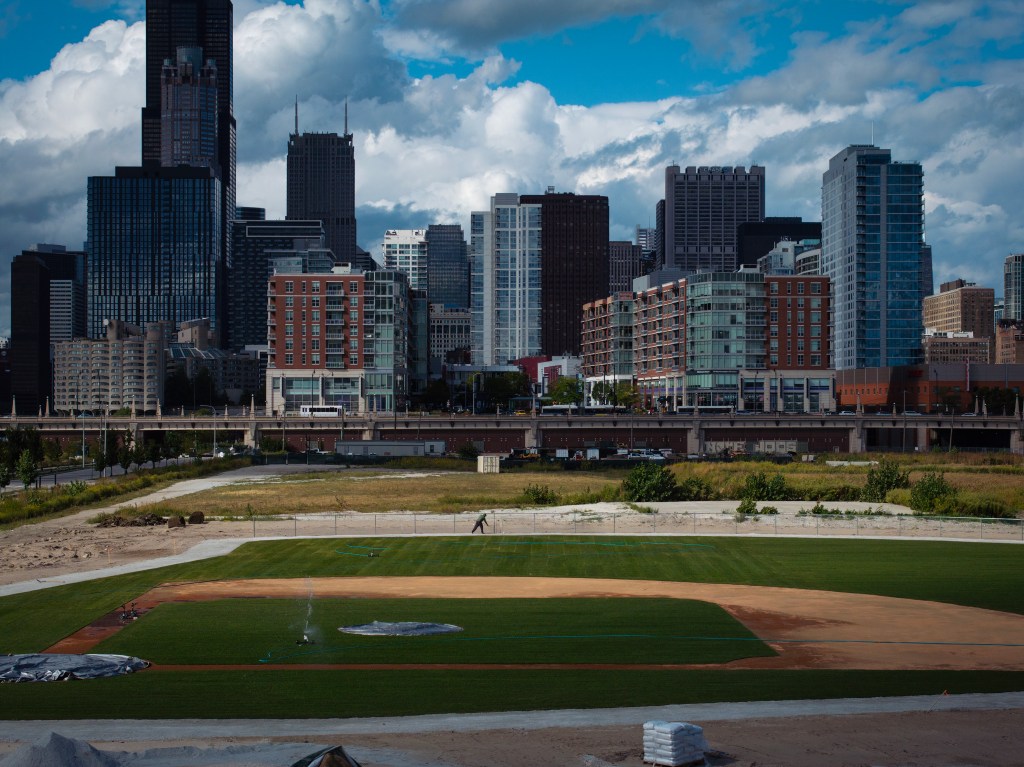Illinois lawmakers on Tuesday said they remained unmoved over the prospect of public funding for a new White Sox stadium a day after the team and real estate developers hosted an event that included a Chicago River cruise to the proposed site for a new ballpark.
The public relations ploy by the Sox and developer Related Midwest gave the handful of legislators who attended a chance to see renderings of a ballpark on The 78 property along the river south of Roosevelt Road and hobnob with former Sox stars Ozzie Guillen, Bo Jackson, Harold Baines and Ron Kittle.
While some lawmakers acknowledged being impressed by the presentation and the site, where team groundskeeper Roger Bossard’s crew has carved out a makeshift diamond, several said they remain skeptical about the use of public money for such a project.
“We say ‘no’ because we all want a shiny new car,” said state Rep. Marcus Evans, a Democrat from Chicago’s South Side who is part of House Speaker Emanuel “Chris” Welch’s leadership team. “Shiny new cars don’t move me. It’s all about the finance.”
The White Sox proposal for taxpayer money is a tall order for a team that has lost 100 games for the second straight season, and comes at a time when the Chicago Bears have also appealed for help from lawmakers to pay for a new football stadium that would cost more than $3 billion before infrastructure costs.
In addition, some lawmakers have said any conversation on public funding for pro sports stadiums has to include financing for women’s teams, such as the Red Stars, which rents space in suburban Bridgeview’s publicly funded SeatGeek Stadium. And lawmakers said several budgetary issues heading into 2025, including public pension reform and school and mass transit funding, need to be addressed first.
“What I’m hearing out there when I talk to people is they’re worried about their grocery bill. They’re worried about paying their mortgage. They’re talking about the things that impact folks at their kitchen tables. They’re not talking about stadiums,” Welch, a Hillside Democrat, said during a City Club of Chicago event Tuesday at a downtown restaurant. “It was a beautiful baseball field with a great view. But again, that doesn’t change the conversation about who pays for it.”
Welch, who played baseball at Northwestern University, acknowledged a new Sox stadium on The 78 site would be great for economic development in the city, but said developers should spend more time considering what private investment options would look like for the venue.
“It was a great presentation on their part,” Welch said of the White Sox. “But the reality is we still represent the taxpayers of the state of Illinois. And they have to change the environment to convince the taxpayers of the state of Illinois that it’s a good idea to have taxpayers pay for a new stadium. And nothing yesterday that I’m aware of changed that environment.”
It’s been seven months since White Sox Chairman Jerry Reinsdorf traveled to Springfield to make his pitch to lawmakers for a new baseball stadium, reportedly with a goal to acquire more than $1 billion in public funding for the ballpark.

State Rep. Bob Rita, a Democrat from Blue Island who was at Monday’s event, said the pitch from the Sox and Related Midwest was compelling but didn’t move the ball in convincing him to grant public funds for the new ballpark.
“I think we’re still at the same place. But it does put a perspective when you’re actually physically seeing something,” said Rita, also part of Welch’s leadership team. “They’ve put a lot of effort in lobbying on one end. The taxpayers are on the other end. And we’ve got to look out for the taxpayers.”
Earlier this year, Related Midwest released drawings of a stadium that included a center-field picnic lawn and a riverwalk with views of the downtown skyline. The developer also offered ambitious but publicly unsubstantiated projections for its economic impact, saying the new ballpark would generate a $9 billion investment, $4 billion in annual economic impact and $200 million in annual tax revenue. Funding sources were not identified.
The plan also called for developing 1,300 new housing units at the Sox’s current home near Bridgeport, while acknowledging the future of that site would be up to a lengthy community process since the property around the park is owned by the Illinois Sports Facilities Authority.
In 1988, Reinsdorf convinced legislators to approve a last-minute deal that led to the construction of Guaranteed Rate Field, where the team has a lease that runs through 2029.The sports facilities authority still owes $50 million on the Sox stadium, which opened in 1991, and $589 million on the 2002 renovation of Soldier Field.
Those bonds are supposed to be repaid with a 2% city hotel tax and annual contributions of $5 million from the city and state. But those funds weren’t enough to cover the debt in the past two years, forcing the city to pay $36 million extra to cover the difference.
State Sen. Steve McClure, a Springfield Republican, said he wasn’t sure why the White Sox wanted a new stadium before he attended Monday’s event. But he said those reasons became clear once he saw the site and “we’ll just have to see what their plan is to pay for it and where it goes from here.”
“It would be a beautiful location. There’s no question about that,” he said of The 78. “It would be kind of a destination ballpark with that kind of a view.”
Originally Published:

